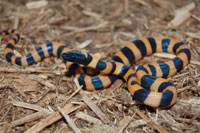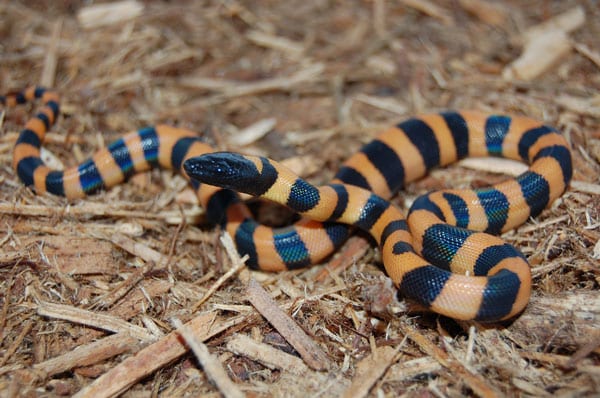Buying captive-born, feeding hatchlings is always recommended, unless you are experienced with many of the tricks to getting small hatchlings to eat.
Click image to enlarge Ringed python. Photo credit: Tom Keogan |
Hatchling Bismarck ringed pythons (Bothrochilus boa) are, in my opinion, one of the most beautiful, high-contrast baby pythons in nature, but they are small and can be tricky to get feeding for their first few meals. Here are a few suggestions that will help you with your hatchlings:
- Buying captive-born, feeding hatchlings is always recommended, unless you are experienced with many of the tricks to getting small hatchlings to eat.
- Given that hatchling ringed pythons are small snakes when first hatched and that they can be escape artists, keep them individually in small, secure cages so they feel safe and settle in quickly. They can be cannibalistic, meaning they will kill and eat each other, so it is important to keep individuals separate.
- Provide at least one snug hiding area and keep the humidity level within it higher than you would keep that of adults, approximately 80 percent. This will help to make sure they shed properly and don’t dehydrate.
- For bedding, I find it easier to keep very young pythons on paper towels while they are small and getting established.
- Move slowly with them. Hatchlings and young animals can, at first, be instinctually defensive due to the fact that, in the wild, they are small, defenseless and low on the food chain. However, allowing them to settle into their surroundings and then conducting short, routine handling sessions can earn the mover their defensive attitude. It is also best to get them out of the cage quickly because they can be more defensive inside their cage, just like several other types of pythons, but they may calm down once out of the cage.
- As hatchlings, they have the same temperature requirements as adults, but in small containers, it is very difficult to get the 75- to 88-degree-Fahrenheit temperature range, so it is best to keep them at around 78 to 84 degrees.
Tom Keogan has kept and bred many types of reptiles for more than 25 years. Tom currently keeps around 30 different species, and in the past 20 years has steadily grown his collection and bred the more exotic difficult-to-breed reptiles. He has kept ringed pythons for almost 20 years, and he is one of the few people consistently breeding them in the United States for the past 15 years. Contact Tom Keogan at blackheadedpython.com.



